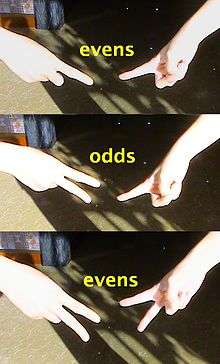Odds and evens (hand game)

Odds and evens, also known as swords, choosies, pick, odds-on poke, or bucking up, is a hand game played between two people,[1] used to decide an issue or for entertainment. This zero-sum game, a variation of the ancient morra and par-impar,[2] is played internationally, especially among children.
The individuals prepare by deciding who will be assigned odds and who will be evens. Then, one or both people say "One, two, three, shoot!" or "once, twice, three, shoot!"[3] As the word "shoot" is said, the two people quickly and simultaneously thrust a fist into the center, extending either an index finger, or both the middle and index finger, indicating one or two. The sum total of fingers displayed is either odd or even. If the result is odd, then the person who called odds is the victor, and can decide the issue as he or she sees fit.[4][5][6] Often, the participants continue to shoot for a best two out of three.[7]
From a game-theoretic perspective, the game is equivalent to matching pennies. See that article for analysis of the strategies and chances of winning.
See also
- Chetno i likho – a game of chance where the players have to guess if the hidden objects are even or odd.
- Coin flipping – a method of making a yes-or-no decision at random.
- Drawing straws – a method of making a group decision - choosing one member of the group.
- Matching pennies – a game of chance with a similar strategic structure, using coins instead of fingers.
- Parity game – an unrelated (and much more complicated) two-player logic game, played on a colored graph.
- Rock-paper-scissors – a game where each player has three alternatives instead of two.
References
- ↑ Cohon, Jared L (2004). Multiobjective Programming and Planning. Courier Dover Publications. p. 234. ISBN 978-0-486-43263-2.
- ↑ "A Dictionary of Greek and Roman Antiquities". www.perseus.tufts.edu. 1890. Retrieved 2016-02-06.
- ↑ https://www.youtube.com/watch?v=4ZOLs03vILs. Missing or empty
|title=(help) - ↑ "Odds and Evens". Elliott Avedon Museum and Archive of Games. University of Waterloo. Retrieved 2011-11-15.
- ↑ Matthews, Patrick (25 October 2010). "Throwing Fingers: Odd & Even". Games For Educators. Retrieved 2011-11-15.
- ↑ "Game Theory" (PDF). Advance Praise for Introduction to Operations Research.
- ↑ Wise, Debra; Forrest, Sandra (2003). Great Big Book of Children's Games. McGraw-Hill Professional. p. 16. ISBN 978-0-07-142246-8.